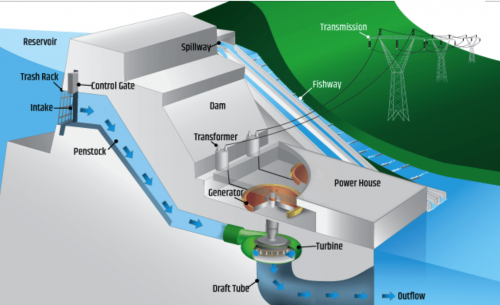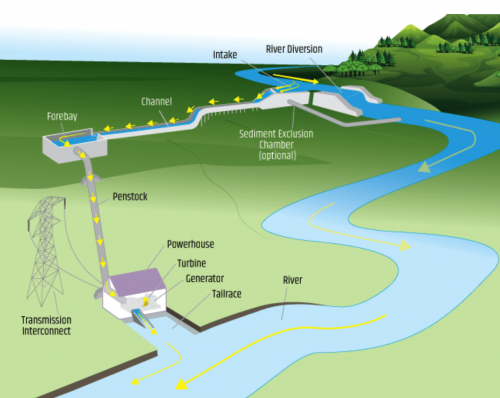Hydropower
Hydropower background
Generating electricity by harnessing the energy in flowing water is called hydroelectric power or simply hydropower. This is mainly done by damming a river and directing a portion of the flow through one or more turbines. Running water is arguably the oldest form of clean energy, having been used for grinding grain, pumping water, and other tasks for millennia. Hydro plants generate 16% of electricity worldwide, and about 6% in the U.S. Hydropower is often inexpensive, but limited to locations where flowing water is available and can be dammed or diverted to spin a turbine. It can be vulnerable to drought, but in most places where it’s widely used, such as in the Pacific Northwest, hydropower is considered a reliable source of clean firm power.
Hydropower Plant, Impoundment Type
Hydropower Plant, Diversion Type
Images: U.S. Department of Energy
Hydropower comes in a vast range of sizes, from huge installations like the 7-gigawatt Grand Coulee Dam in Washington or the 22.5-gigawatt Three Gorges Dam in China to a privately owned 10-kilowatt micro-hydropower system.
How hydropower supports a clean and stable electric grid
Hydropower generates firm power without directly emitting greenhouse gases. It’s a low-tech way of harnessing the sun’s power. According to the U.S. Department of Energy, hydropower currently generates 260 terawatt-hours (TWh), or 6.3% of U.S. electricity demand, but they point to significant additional potential that could double that.
Hydropower is also dispatchable — can be turned on and off — because its output can be adjusted simply by modulating water flow through the turbine(s). This is more important than the modest hydro contribution to total grid capacity would suggest, because it can be a key balancing resource for intermittent renewables without the need to fall back on fossil energy.
Hydropower can be built with abundant, easily obtainable, domestically sourced materials and, of course, uses no fuel. It also can confer community benefits such as flood control, irrigation support, and clean drinking water.
Issues with hydropower
Hydropower does have some limitations. Suitable locations require a dependable natural water supply accompanied by changes in elevation that are sufficient to pressurize water through a turbogenerator. It is also vulnerable to weather conditions: the Department of Energy reported that U.S. hydropower output from 1990 to 2010 fluctuated by ±12%; and the International Energy Agency estimated that in 2021, even though global hydropower capacity grew, output decreased 0.4% due to drought in five countries.
Although generating electricity from hydropower doesn’t directly produce CO2 emissions, reservoirs upstream of dams can produce significant CO2 and methane emissions from microbial action on sediments. But a 2021 study found those emissions to be 23 grams of CO2-equivalent per kilowatt-hour, which is about 95% lower than greenhouse gas emissions from U.S. natural gas power.
Emissions are not the only concern from construction of big dams, however. Large hydropower projects can lead to conflicts by displacing local communities, and natural habitats, including important fisheries, can be disrupted if a careful balance between energy needs and ecosystem services is not established. Perhaps the most discussed impact is disruption of fish migration. There are other, more subtle ecological impacts as well, but fortunately there are solutions such as incorporating various kinds of fish passes and using adaptive reservoir release to optimize ecosystem water temperature.
How much could hydropower contribute to a clean and stable electric grid?
The relative contribution of various fossil-free technologies to a net-zero outcome is subject to many assumptions. Predicted U.S. hydropower growth in net-zero scenarios from both Princeton and Energy Innovation have been essentially flat, staying around 260-280 TWh. Globally, the hydropower forecasts have varied much more widely, with 2050 predictions ranging from 11,000 TWh all the way down to zero, compared to a 2020 level of 4,200 TWh. How this plays out depends on how durable the growth in wind, solar, and energy storage will be. Under any scenario, the U.S. DOE estimate of potential additional hydropower (347 TWh) provides some reassurance against unforeseen obstacles in the growth of other clean power sources.
Other FAQs
What about pumped hydro?
Excess renewable energy generated during times of low demand can be pumped uphill to an artificially constructed reservoir to be later exploited for power generation during times of higher demand. This common form of energy storage is called pumped hydro. This technology is covered separately under the Energy Storage training.
Aren't most locations suitable for hydropower already developed?
That depends on where the needs are. In the U.S., the conventional wisdom says that there are not many potential hydropower sites left. However, the Department of Energy has reported that the additional potential, excluding federally protected areas, is 347 TWh, which could raise hydro’s contribution to the projected 2050 demand from the current 6% to as much as 12%. One of the ways to increase hydropower without building new dams from scratch is to retrofit existing dams that don’t currently include power generation.
What impact do reservoirs have on natural habitats?
Depending on the quality of management, this can vary quite a bit. As outlined in an MIT analysis, “Dams and reservoirs can reduce river flows, raise water temperature, degrade water quality and cause sediment to build up,” which can negatively impact fish, birds and other wildlife. Thermal stratification in reservoirs, exacerbated by deaeration when water passes through the turbine, can cause dissolved oxygen levels to drop too low. Silt accumulation, turbidity, and organic material decomposition in the reservoir can put the survival of native aquatic species in doubt. Fortunately, there are remedies, provided regulatory and/or economic incentives are in place.

